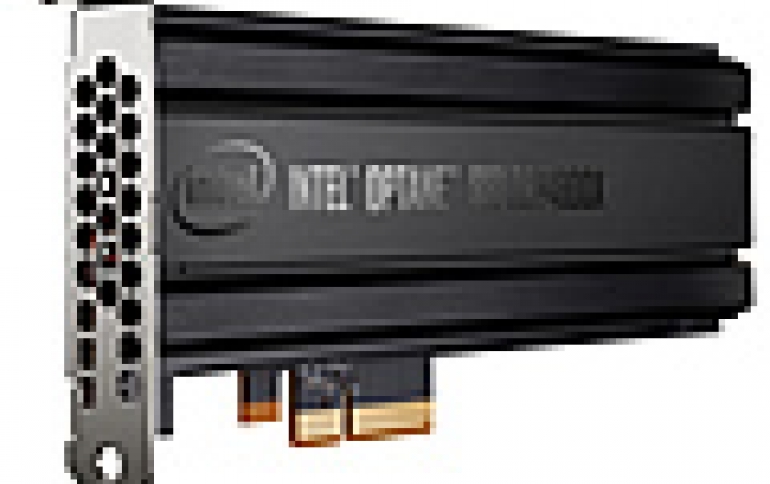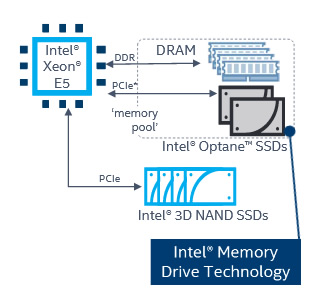
Intel Introduces New Optane DC P4800X SSDs For Data Centers
Today, Intel unveiled the Intel Optane SSD DC P4800X Series and Intel Optane SSD DC P4800X Series with Intel Memory Drive Technology, combining storage and memory architectures for the data center.
Deployed as fast storage or caching tier, Intel Optane SSD DC P4800X has been designed to increase scale per server and accelerate applications. When deployed as extended memory, this drive expands the system memory pool, creating bigger, more cost-effective memory to gain higher quality insights.
Intel Optane technology is a combination of 3D XPoint memory media with Intel's system memory controller (supports seven channels, initial 375 GByte drive uses four media die per channel, or 28 die total,) interface hardware and software IP.

3D Xpoint is a form of memory that stores data based on the resistance of cells. Intel developed 3D Xpoint with Micron, which later this year will release an Optane competitor called QuantX, aimed at enterprise SSDs.
The DC P4800X is a server drive riding the NVMe interface, initially available in a 375-GByte version that lists for a retail price of $1,520, about three times the cost of a similar NAND card. It delivers less than 20-microsecond read-and-write latencies and a 30-disk-writes/day endurance with an estimated three-year lifetime.

Intel Optane SSDs offer high performance at low queue depth, where the vast majority of applications generate storage workloads, which means CPUs are more active and more fully utilized. And because the drive is extremely responsive under any load, it is highly predictable and delivers ultra-fast service.
Where NAND-based SSDs are often measured at a queue depth of 32 (SATA) or 128 (NVMe) in order to showcase maximum throughput, the DC P4800X can reach as much as 500,000 IOPS, or ~2GB/s, at a queue depth of 11, according to Intel.
Genrally, Optane lights up when running random reads and writes, which are common in servers and high-end PCs. Optane?s random writes reach up to 10 times faster compared to conventional SSDs, but only when utilization is being pushed to extremes, while reads are around three times faster.
According to Intel, in a standard 4K data block, with 70 percent read and 30 percent write, the P4800X was five to eight times faster than the older P3700. The responsiveness of the drive increased with the data load.
- Capacity: 375GB
- Form Factor: Add-in-Card (AIC); Half-height, Half-length, Low-profile
- Interface: PCIe 3.0 x4, NVMe
- Latency (typical) R/W: <10μs
- Quality of Service (QoS): 99.999%:
- 4kB Random Queue Depth 1, R/W: <60/100 μs
- 4kB Random Queue Depth 16, R/W: <150/200 μs
- Throughput:
- IOPS Random 4kB R/W: Up to 550/500k
- IOPS Random 4kB 70/30 Mixed R/W: Up to 500k
- Endurance
- 30 Drive Writes per day (JESD219 workload)
- 12.3 Petabytes Written (PBW)
- Price: $1,520 SSD
Along with the DC P4800X, Intel is launching Intel Memory Drive Technology software as a paid add-on. Intel Optane SSD DC P4800X with Intel Memory Drive Technology enables data centers to deliver more affordable memory pools by displacing a portion of DRAM or increasing the size of memory pools. This solution integrates the drive into the memory subsystem and presents the SSD as DRAM to the OS and applications.
Intel Memory Drive Technology has a substantial capacity overhead: a 375GB Optane SSD can provide up to 320GB of virtual memory. Multiple Optane SSDs can be used to provide virtual memory up to ten times the system's DRAM capacity.

The full licensing cost structure for Intel Memory Drive Technology is not clear, but the MSRP for a 375GB P4800X bundled with Memory Drive Technology is $1951 compared to $1520 for the SSD alone. The Memory Drive Technology hypervisor must be booted from a USB device or an IDE-compatible storage controller, and the guest operating system cannot be booted in UEFI mode. Intel Xeon E5-x6xx v2 or later and E7- x8xx v2 or later processors are supported.
- Memory Capacity: 320 GiB
- Operating Systems:
- RHEL 6.5, 6.6, 6.7, 6.8 ,7.0, 7.1, 7.2, 7.3
- SLES 11 SP4, 12, 12 SP1, 12 SP2
- Intel Memory Drive Technology Software requires a bootable media.
- Supported protocols: IDE, UHCI, EHCI.
- Linux OS must be installed in legacy (non-UEFI) mode
- Supported Processors: Intel Xeon E5-x6xx v2 or later, E7-x8xx v2 or later
- Maximum Processor Sockets: 8
- Maximum Software-defined Memory:64 TiB
- Recommended DRAM Expansion: Up to 8x
- Hot-plug: Hot-plug is not supported
- Form Factor: Add-in-Card (AIC); Half-height, Half-length, Low-profile
- Interface: PCIe 3.0x4, NVMe
- Power:
- AIC: 12V (3.3V Aux) Supply Rail
- Active/Idle: Up to 18 W/5 W (TYP)
Intel Optane SSD DC P4800X Series (375GB, Add in Card) and Intel Optane SSD DC P4800X with Intel Memory Drive technology is available now in an early ship program. Intel says an enterprise Optane SSD with 750GB will ship in the second quarter, and that a 1.5TB SSD will ship in the second half of this year. Optane will also ship in the form of DRAM modules next year. Intel did not share information on when it would ship consumer SSDs.





















